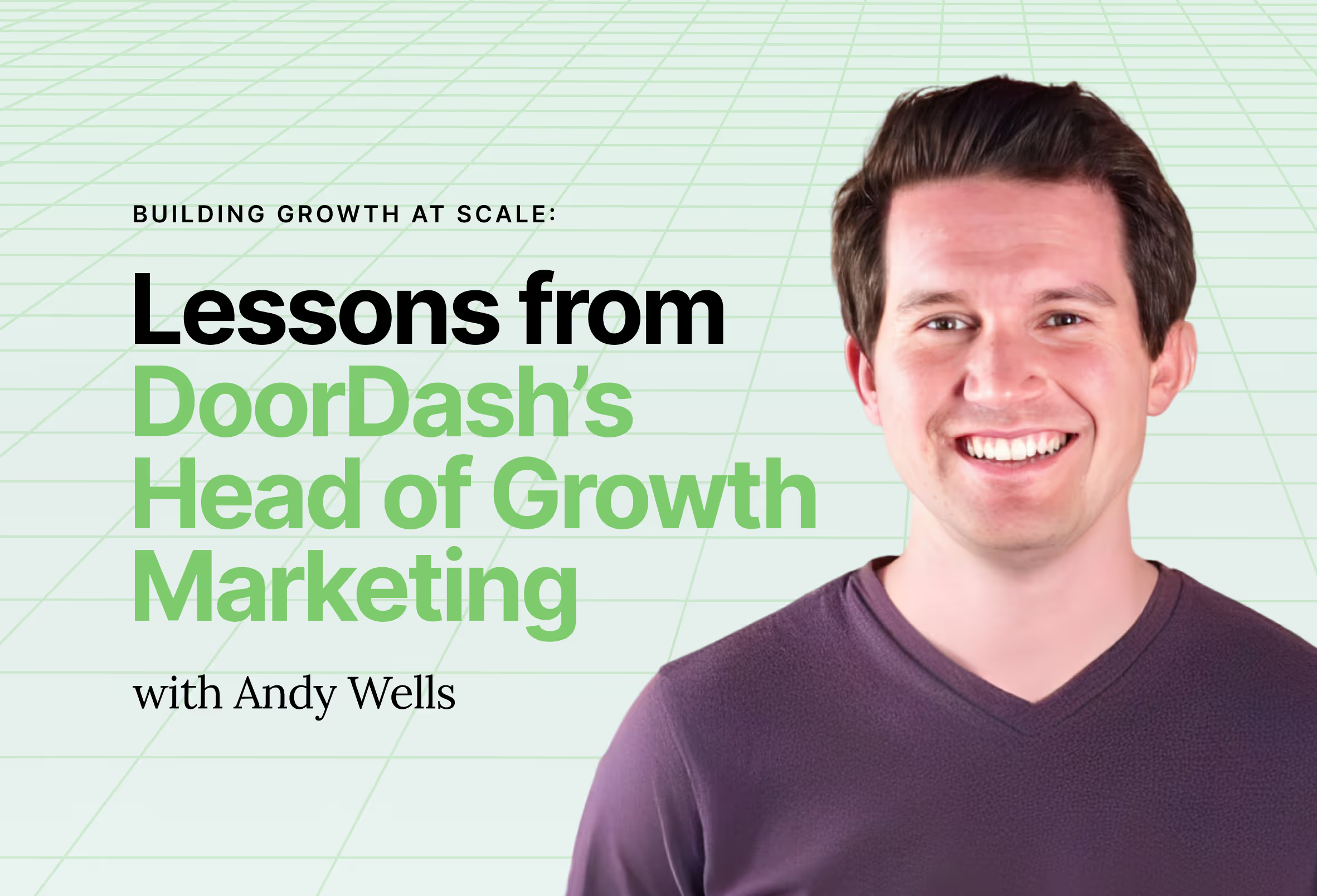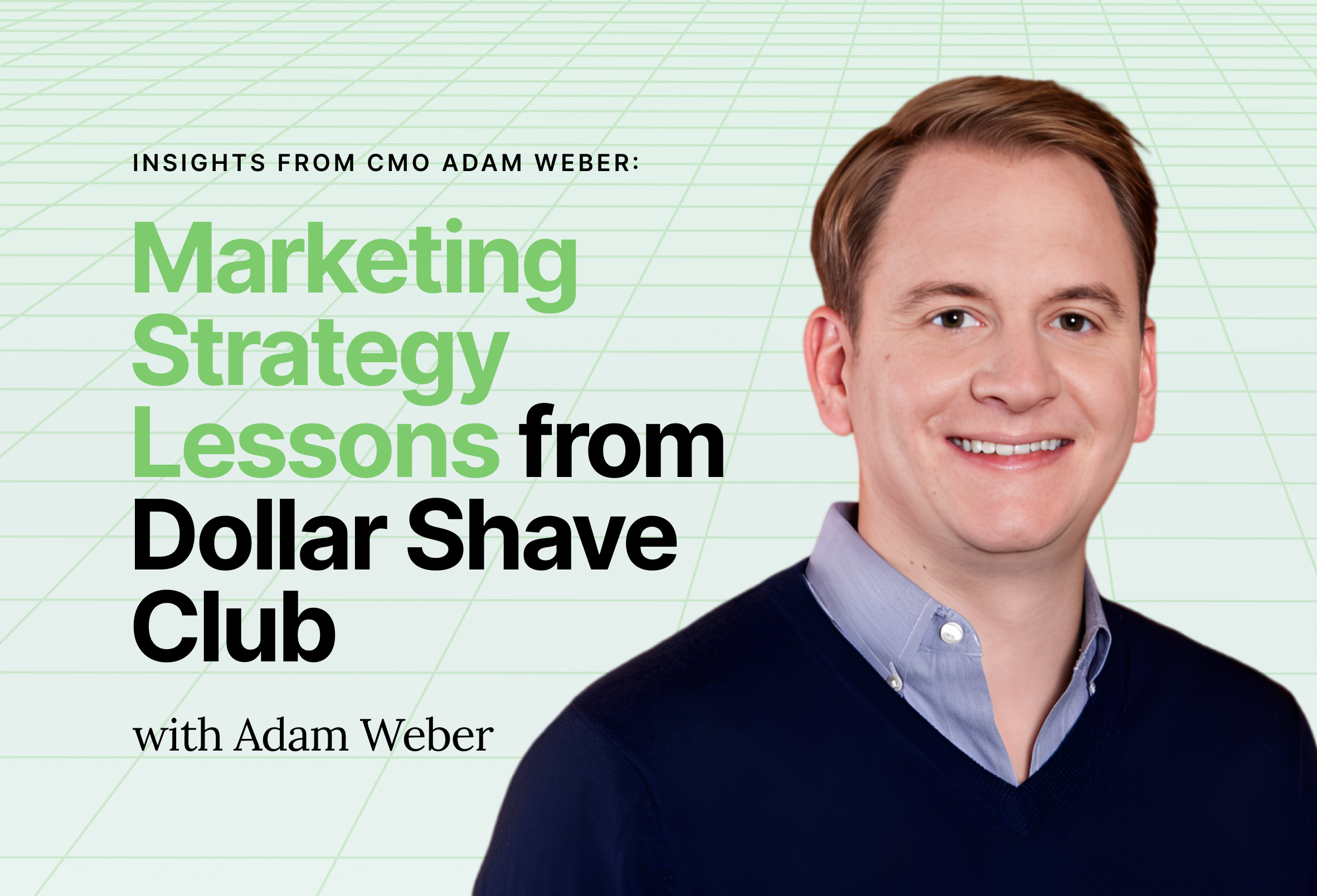TL;DR (Fast Facts)
- Speaker: Andy Wells, Head of Growth Marketing at DoorDash
- Team size: 80+ growth marketers, 250 in marketing overall
- Marketplace: Three-sided — consumers, dashers, merchants
- Top channels: Paid search, social, job boards, Google Shopping Ads
- Retention drivers: DashPass subscription, personalized lifecycle marketing
- Philosophy: Customer-obsessed, not competitor-focused
- Leadership lesson: Hire marketing athletes, not just specialists
Growth marketing has never been more complex. Brands compete across dozens of channels, customer expectations keep rising, and retention is as critical as acquisition. Few companies embody this challenge better than DoorDash, the food delivery giant that grew from a startup in 2013 to a market leader with over 67% U.S. share today.
In a recent webinar, Andy Wells, Head of Growth Marketing at DoorDash, sat down with Jesse Pujji (Ampush co-founder) to share his journey. Andy discussed his career path, the mechanics of a three-sided marketplace, the channels and retention levers that drive growth, and how to build flexible marketing teams at scale.
This article breaks down the key lessons for growth marketers, founders, and CMOs who want to apply DoorDash-style thinking to their own brands.
Andy Wells’ Career Path: From Teaching to Tech Growth Leader
Andy’s career is anything but linear. After studying economics and Chinese, he spent two years teaching English in China. When he returned to the U.S., he discovered growth marketing — a field that combined his interest in problem-solving, analytics, and creativity.
Ampush Years: The Growth Marketing Bootcamp
In 2012, Andy joined Ampush, a performance marketing firm specializing in Facebook advertising at the time. His key takeaways included:
- Problem-solving over playbooks: Ampush empowered employees to experiment with new ad formats, industries, and strategies instead of relying on rigid formulas.
- Extreme ownership: Because client contracts were structured around CPA goals, Andy learned to treat client budgets like his own — managing spend, staffing, and ROI with an operator’s mindset.
- Cross-industry exposure: Working across multiple verticals helped him see how growth principles could be adapted for different business models.
Transition to DoorDash
In 2018, Andy joined DoorDash at a pivotal moment. The company was:
- Not yet the category leader (competing with Uber Eats and Grubhub).
- Growing primarily through organic channels like new market launches and merchant onboarding.
- Operating with a tiny acquisition team — Andy plus one other marketer.
Fast forward to today: DoorDash employs 20,000 people globally, with 250 marketers company-wide and 80+ in growth marketing under Andy’s leadership.
Building Growth in a Three-Sided Marketplace
Most businesses operate in a two-sided model (buyer + seller). DoorDash, however, is a three-sided marketplace:
- Consumers (people ordering meals, groceries, or retail products).
- Dashers (delivery drivers).
- Merchants (restaurants and retailers).
Each side influences the others, and imbalance on one side can ripple across the ecosystem.
- Too many dashers, not enough demand → poor driver retention.
- Too few dashers, too much demand → slow deliveries, cold food, unhappy customers.
- Insufficient merchants → limited selection, low customer adoption.
This balancing act creates operational challenges but also forms a competitive moat. Once DoorDash achieved scale in a market, new entrants struggled to compete.
Channel Strategies: From Paid Search to Google Shopping Ads
DoorDash’s growth channels evolved significantly over time.
Consumer Acquisition
- Paid search & app display: Early focus on high-intent users.
- Social ads: Scaled demand generation at lower CAC.
- Direct mail: Surprisingly effective at household penetration.
- Google Shopping Ads: A difficult but rewarding channel once DoorDash expanded into groceries and retail.
“Search became one of the best awareness drivers for DoorDash beyond restaurants. Once people tried us for grocery or retail, retention skyrocketed.” – Andy Wells
Dasher Acquisition
- Short-term incentives: Surge pay, bonuses during events (e.g., concerts, holidays).
- Job boards: Effective for part-time work seekers.
- Paid search & social: Targeted campaigns in under-supplied markets.
- Referrals: Flexible lever with payouts ranging from $100 to $1,000 depending on market need.
Merchant Acquisition
- Self-serve onboarding: Most merchants joined directly through DoorDash’s platform.
- Sales support: Enterprise partnerships with national chains (e.g., Chipotle, Best Buy).
- Retention tracking: Focused on the first 30-day order volume as a success metric.
Metrics That Drive Growth
Andy emphasized the importance of tying marketing back to business outcomes — not just inputs like impressions or clicks.
- Consumers: CAC, MAUs, DashPass adoption, vertical expansion (grocery, convenience, retail).
- Dashers: Acquisition cost per market, retention, active hours driven.
- Merchants: Onboarding completions, retention, order growth.
Attribution Approach
- Direct attribution where possible (via MMPs, web tracking).
- Incrementality testing to validate true impact.
- Media Mix Modeling (MMM) for long-term budget allocation.
- Pragmatism: “If something looks too good to be true, it probably is.”
Building Flexible Teams: Marketing Athletes vs. Specialists
DoorDash organizes its growth marketing org around three sub-teams:
- Paid media
- Owned channels (CRM)
- Martech
Within each, pods are dedicated to consumer, dasher, or merchant goals. This hybrid approach balances specialization with audience-centric ownership.
Andy’s leadership philosophy includes:
- Hiring “marketing athletes” who can adapt to new channels.
- Encouraging cross-pod knowledge sharing through monthly sessions.
- Delegating business goals (not just tasks) to leaders, enabling autonomy and accountability.
Retention Levers: Beyond Acquisition
Scaling acquisition is expensive; retention multiplies ROI.
DoorDash’s retention strategy centers on:
- DashPass Subscription: Reduces delivery and service fees. Customers only need 2+ orders per month to justify it, creating stickiness.
- Personalized Lifecycle Marketing: Using first-party data to deliver relevant offers (e.g., discounts for lapsed customers at favorite restaurants).
- Vertical Expansion: Encouraging customers to try grocery, retail, and convenience orders to deepen engagement.
Competitor Awareness Without Obsession
DoorDash adopts an “obsess over customers, not competitors” philosophy.
- Example: Instead of fighting for NYC/LA, DoorDash grew aggressively in suburbs and secondary markets, where competition was low but demand was high.
- Still, the team tracks competitor moves . e.g., copying Instacart’s early use of Google Shopping Ads.
This balance ensures strategic differentiation while learning from the market.
AI and the Future of Growth Marketing
Andy’s team currently uses AI in two main ways:
- Channel optimization: Leveraging Google and Meta’s algorithms by feeding them clean, broad signals.
- Creative generation: Testing AI-assisted creative variations for seasonal or localized campaigns.
While AI hasn’t replaced human creativity, Andy sees it as a scaling tool for testing.
GrowthAssistant: Scaling Without Adding Headcount
One recurring challenge for large teams is bandwidth. DoorDash partnered with GrowthAssistant to offload manual but critical tasks (e.g., PO management, invoicing).
Benefits included:
- Freeing in-house teams to focus on strategy.
- Improving retention of U.S. employees by removing repetitive work.
- Providing career growth opportunities for offshore talent eager to work with tech companies.
This model represents a growing trend: blended teams of strategic marketers supported by offshore operators.
Ready to Build Your Own Growth Engine?
Growth marketing isn’t just about running ads. It’s about:
- Understanding your ecosystem (whether two-sided or three-sided).
- Aligning teams around business goals, not vanity metrics.
- Balancing acquisition with retention for long-term ROI.
DoorDash’s playbook proves that growth at scale requires customer obsession, operational flexibility, and smart delegation.
Whether you’re a startup founder or marketing leader, ask yourself: What would it look like to treat every customer segment as a true partner in growth?










.svg)

